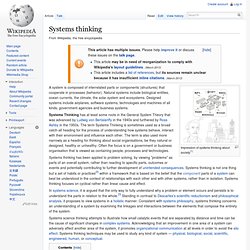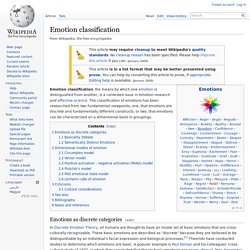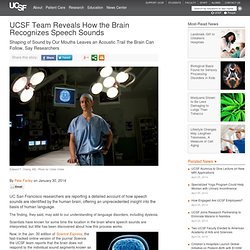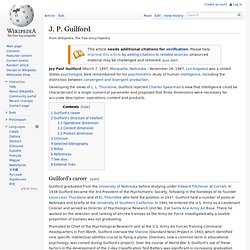

Gardner´s+Multiple+Intelligences+Theory.jpg (Image JPEG, 1600x878 pixels) - Redimensionnée (80. Intelligence Forms. Systems thinking. Impression of systems thinking about society[1] A system is composed of interrelated parts or components (structures) that cooperate in processes (behavior).

Natural systems include biological entities, ocean currents, the climate, the solar system and ecosystems. Designed systems include airplanes, software systems, technologies and machines of all kinds, government agencies and business systems. Systems Thinking has at least some roots in the General System Theory that was advanced by Ludwig von Bertalanffy in the 1940s and furthered by Ross Ashby in the 1950s. The term Systems Thinking is sometimes used as a broad catch-all heading for the process of understanding how systems behave, interact with their environment and influence each other. Systems thinking has been applied to problem solving, by viewing "problems" as parts of an overall system, rather than reacting to specific parts, outcomes or events and potentially contributing to further development of unintended consequences. Intellectual Myths. Emotion classification.
Emotion classification, the means by which one emotion is distinguished from another, is a contested issue in emotion research and affective science.

The classification of emotions has been researched from two fundamental viewpoints: one, that emotions are discrete and fundamentally different constructs; or two, that emotions can be characterized on a dimensional basis in groupings. Emotions as discrete categories[edit] Basicality Debate[edit] Humans' subjective experience is that emotions are clearly recognizable in ourselves and others. This apparent ease of recognition has led to the identification of a number of emotions that are said to be basic, and universal among all people. On "basic emotion" accounts, activation of an emotion, such as anger, sadness, or fear, is "triggered" by the brain's appraisal of a stimulus or event with respect to the perceiver's goals or survival.
Semantically Distinct Emotions[edit] Team Reveals How the Brain Recognizes Speech Sounds. UC San Francisco researchers are reporting a detailed account of how speech sounds are identified by the human brain, offering an unprecedented insight into the basis of human language.

The finding, they said, may add to our understanding of language disorders, including dyslexia. Scientists have known for some time the location in the brain where speech sounds are interpreted, but little has been discovered about how this process works. Now, in the Jan. 30 edition of Science Express, the fast-tracked online version of the journal Science, the UCSF team reports that the brain does not respond to the individual sound segments known as phonemes – such as the b sound in “boy” – but is instead exquisitely tuned to detect simpler elements, which are known to linguists as “features.” The work may add to our understanding of reading disorders, in which printed words are imperfectly mapped onto speech sounds. Breaking Down Speech into Acoustic Features How Does Your Brain Process Spoken Words?
Promises and Perils on the Road to Superintelligence. Global Brain / Image credit: mindcontrol.se In the 21st century, we are walking an important road.

Our species is alone on this road and it has one destination: super-intelligence. The most forward-thinking visionaries of our species were able to get a vague glimpse of this destination in the early 20th century. Paleontologist Pierre Teilhard de Chardin called this destination Omega Point. Mathematician Stanislaw Ulam called it “singularity”: One conversation on the ever accelerating progress of technology and changes in the mode of human life, which gives the appearance some essential singularity in the history of the race beyond which human affairs, as we know them, could not continue. For thinkers like Chardin, this vision was spiritual and religious; God using evolution to pull our species closer to our destiny. Today the philosophical debates of this vision have become more varied, but also more focused on model building and scientific prediction. Promise #1: Omniscience Cadell Last. Guilford's Structure of Intellect. Developing the views of L.

L. Thurstone, Guilford rejected Charles Spearman's view that intelligence could be characterized in a single numerical parameter and proposed that three dimensions were necessary for accurate description: operations, content and products. Guilford's career[edit] Guilford graduated from the University of Nebraska before studying under Edward Titchener at Cornell.
In 1938 Guilford became the 3rd President of the Psychometric Society, following in the footsteps of its founder Louis Leon Thurstone and of EL Thorndike who held the position in 1937. Promoted to Chief of the Psychological Research Unit at the U.S.